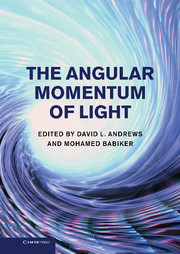Book contents
- Frontmatter
- Contents
- List of contributors
- Preface
- 1 Light beams carrying orbital angular momentum
- 2 Vortex transformations and vortex dynamics in optical fields
- 3 Vector beams in free space
- 4 Optical beams with orbital angular momentum in nonlinear media
- 5 Ray optics, wave optics and quantum mechanics
- 6 Quantum formulation of angle and orbital angular momentum
- 7 Dynamical rotational frequency shift
- 8 Spin-orbit interactions of light in isotropic media
- 9 Quantum electrodynamics, angular momentum and chirality
- 10 Trapping of charged particles by Bessel beams
- 11 Theory of atoms in twisted light
- 12 An experimentalist's introduction to orbital angular momentum for quantum optics
- 13 Measurement of light's orbital angular momentum
- 14 Efficient generation of optical twisters using helico-conical beams
- 15 Self-similar modes of coherent diffusion with orbital angular momentum
- 16 Quantum entanglement of orbital angular momentum
- Index
- References
2 - Vortex transformations and vortex dynamics in optical fields
Published online by Cambridge University Press: 05 December 2012
- Frontmatter
- Contents
- List of contributors
- Preface
- 1 Light beams carrying orbital angular momentum
- 2 Vortex transformations and vortex dynamics in optical fields
- 3 Vector beams in free space
- 4 Optical beams with orbital angular momentum in nonlinear media
- 5 Ray optics, wave optics and quantum mechanics
- 6 Quantum formulation of angle and orbital angular momentum
- 7 Dynamical rotational frequency shift
- 8 Spin-orbit interactions of light in isotropic media
- 9 Quantum electrodynamics, angular momentum and chirality
- 10 Trapping of charged particles by Bessel beams
- 11 Theory of atoms in twisted light
- 12 An experimentalist's introduction to orbital angular momentum for quantum optics
- 13 Measurement of light's orbital angular momentum
- 14 Efficient generation of optical twisters using helico-conical beams
- 15 Self-similar modes of coherent diffusion with orbital angular momentum
- 16 Quantum entanglement of orbital angular momentum
- Index
- References
Summary
Introduction
Vortices and vorticity are common objects of study in the field of fluid dynamics [1]. In a fluid, vortices appear as spinning, often turbulent, flows, giving rise to common phenomena such as tornadoes and whirlpools. In their more discreet manifestations, fluid vortices are thought to be responsible for the destruction of bridges due to the formation of vortex streets and structural resonance [2] and for the flight of insects [3], ending a long debate in the community about the reversibility of the movement of insect wings. Because of the importance of all those natural phenomena, the study of vortex dynamics and the creation and annihilation of hydrodynamical vortices is a matter of intense study.
When the first properties of superfluids were found, the question of whether vortices could appear in such irrotational fluids was addressed by prominent scientists [4, 5]. It was found that vortices could also appear in such systems, but they could only appear as point vortices, i.e. singular locations where the vorticity of the fluid was infinite, whereas everywhere else the vorticity was strictly zero. This property was also found later on in Bose-Einstein condensates (BECs), where the quest for exciting and controlling the point vortices of quantum systems is still a hot topic. The dynamics of and processes related to the birth and destruction of vortex-antivortex pairs play an important role in the physics of these exotic systems.
- Type
- Chapter
- Information
- The Angular Momentum of Light , pp. 31 - 50Publisher: Cambridge University PressPrint publication year: 2012
References
- 1
- Cited by

